
Isabella d'Este was Marchioness of Mantua and one of the leading women of the Italian Renaissance as a major cultural and political figure. She was a patron of the arts as well as a leader of fashion, whose innovative style of dressing was copied by numerous women. The poet Ariosto labeled her as the "liberal and magnanimous Isabella", while author Matteo Bandello described her as having been "supreme among women". Diplomat Niccolò da Correggio went even further by hailing her as "The First Lady of the world".
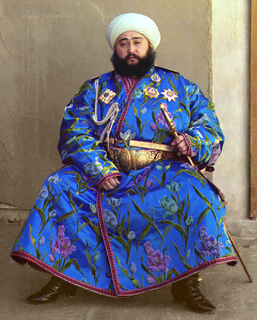
A turban is a type of headwear based on cloth winding. Featuring many variations, it is worn as customary headwear by people of various cultures. Communities with prominent turban-wearing traditions can be found in the Indian subcontinent, Southeast Asia, the Arabian Peninsula, the Middle East, the Balkans, the Caucasus, Central Asia, North Africa, West Africa, East Africa, and amongst some Turkic peoples in Russia as well as Ashkenazi Jews.

The mohawk is a hairstyle in which, in the most common variety, both sides of the head are shaven, leaving a strip of noticeably longer hair in the center. It is today worn as an emblem of non-conformity.

Fashion in the period 1550–1600 in Western European clothing was characterized by increased opulence. Contrasting fabrics, slashes, embroidery, applied trims, and other forms of surface ornamentation remained prominent. The wide silhouette, conical for women with breadth at the hips and broadly square for men with width at the shoulders had reached its peak in the 1530s, and by mid-century a tall, narrow line with a V-lined waist was back in fashion. Sleeves and women's skirts then began to widen again, with emphasis at the shoulder that would continue into the next century. The characteristic garment of the period was the ruff, which began as a modest ruffle attached to the neckband of a shirt or smock and grew into a separate garment of fine linen, trimmed with lace, cutwork or embroidery, and shaped into crisp, precise folds with starch and heated irons.

The hennin was a headdress in the shape of a cone, steeple, or truncated cone worn in the late Middle Ages by European women of the nobility. They were most common in Burgundy and France, but also elsewhere, especially at the English courts, and in Northern Europe, Hungary and Poland. They were little seen in Italy. It is unclear what styles the word hennin described at the time, though it is recorded as being used in French areas in 1428, probably before the conical style appeared. The word does not appear in English until the 19th century. The term is therefore used by some writers on costume for other female head-dresses of the period.

The kokoshnik is a traditional Russian headdress worn by women and girls to accompany the sarafan. The kokoshnik tradition has existed since the 10th century in the ancient Russian city Veliky Novgorod. It spread primarily in the northern regions of Russia and was very popular from 16th to 19th century. It is still to this day an important feature of Russian dance ensembles and folk culture and inspired the Kokoshnik style of architecture.

Fashion in the period 1500–1550 in Western Europe is marked by very thick, big and voluminous clothing worn in an abundance of layers. Contrasting fabrics, slashes, embroidery, applied trims, and other forms of surface ornamentation became prominent. The tall, narrow lines of the late Medieval period were replaced with a wide silhouette, conical for women with breadth at the hips and broadly square for men with width at the shoulders. Sleeves were a center of attention, and were puffed, slashed, cuffed, and turned back to reveal contrasting linings.

Fashion in 15th-century Europe was characterized by a series of extremes and extravagances, from the voluminous robes called houppelandes with their sweeping floor-length sleeves to the revealing doublets and hose of Renaissance Italy. Hats, hoods, and other headdresses assumed increasing importance, and were draped, jewelled, and feathered.

Portrait of Princess is a tempera painting on panel attributed to the Italian Late-Gothic master Pisanello. It was probably executed between 1435 and 1445 and is also known as Portrait of a Princess of the House of Este. It is firmly attributed to Pisanello on stylistic grounds and because he stayed in Ferrara in the period, where he also finished a portrait and a celebrative medal of Marquis Leonello d'Este.

A fontange, or frelange, is a high headdress popular during the turn of the late 17th and early 18th centuries in Europe. Technically, fontanges are only part of the assembly, referring to the ribbon bows which support the frelange. The frelange was supported by a wire framework called a commode. A surviving example of a frelange headdress with fontanges and commode in situ is that worn by the 1690s fashion doll Lady Clapham. In England, the style was popularly known as a 'top-knot', versions of which were worn by ladies of all ranks, from the Queen downwards to kitchen maids, making it an easy target for satire and criticism.

Portrait of a Lady is a small oil-on-oak panel painting executed around 1460 by the Netherlandish painter Rogier van der Weyden. The composition is built from the geometric shapes that form the lines of the woman's veil, neckline, face, and arms, and by the fall of the light that illuminates her face and headdress. The vivid contrasts of darkness and light enhance the almost unnatural beauty and Gothic elegance of the model.
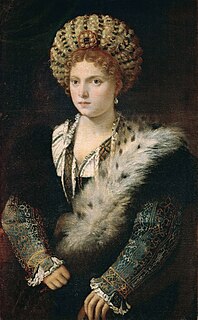
Isabella in Black is a portrait of a young woman by Titian. It can be dated to the 1530s and is in the Kunsthistorisches Museum in Vienna. The artist and the date are undisputed. Beyond the museum documentaton, there are repeated doubts about the person depicted.

Headgear, headwear, or headdress is the name given to any element of clothing which is worn on one's head, including hats, helmets, turbans and many other types. Headgear is worn for many purposes, including protection against the elements, decoration, or for religious or cultural reasons, including social conventions.
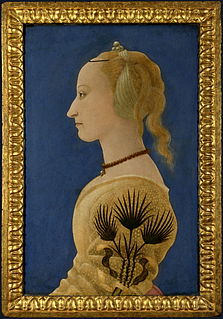
Portrait of a Lady in Yellow was painted by the Florentine artist Alesso Baldovinetti sometime in the second half of the 15th century, most likely c. 1465. For centuries the work was mis-attributed; it was purchased by the National Gallery London in 1866 as a portrait of Countess Palma of Urbino, attributed to Piero della Francesca. In 1911 art historian Roger Fry established that it was by Baldovinetti. However, there is no evidence of the source of the commission, and doubt remains as to the identity of the sitter; the most plausible theory is that she is Francesca degli Stati of Urbino.
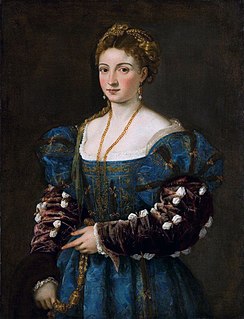
La Bella is a portrait of a woman by Titian in the Palazzo Pitti in Florence. The painting shows the subject with the ideal proportions for Renaissance women. In parallel the stringent composition corresponds to Titian's real portraits. The work can be dated by a letter about “that portrait of that woman in a blue dress“ in May 1536.
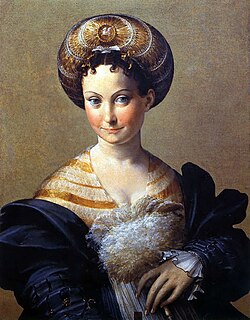
Turkish Slave is a painting by the Italian Mannerist artist Parmigianino, executed around 1533. It is housed in the Galleria nazionale di Parma, northern Italy.

History of clothing in the Indian subcontinent can be traced to the Indus Valley Civilization or earlier. Indians have mainly worn clothing made up of locally grown cotton. India was one of the first places where cotton was cultivated and used even as early as 2500 BCE during the Harappan era. The remnants of the ancient Indian clothing can be found in the figurines discovered from the sites near the Indus Valley Civilisation, the rock-cut sculptures, the cave paintings, and human art forms found in temples and monuments. These scriptures view the figures of human wearing clothes which can be wrapped around the body. Taking the instances of the sari to that of turban and the dhoti, the traditional Indian wears were mostly tied around the body in various ways.

Profile Portrait of a Lady is oil on panel painting by an unknown Franco-Flemish artist, dated to about 1410. It is housed in the National Gallery of Art, Washington.

Portrait of Cecilia Gozzadini is an oil painting attributed to Parmigianino, dated to around 1530 and now held at the Kunsthistorisches Museum in Vienna.

Isabella in Red is a portrait of a woman by Peter Paul Rubens in the Kunsthistorisches Museum in Vienna. It is considered a close copy of a lost Titian original.























